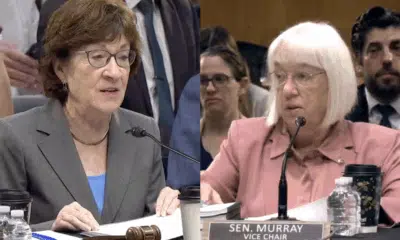News from the South - North Carolina News Feed
Concerns about lead in the water? Surprising ability to treat high-turbidity water? What are the plans to prevent another outage? And more… • Asheville Watchdog
Even though the City of Asheville is once again delivering potable water after Tropical Storm Helene devastated the water system Sept. 27, serious questions about the water’s safety, and the future of the water system remain.
Readers have sent dozens of questions to Asheville Watchdog, so we’ve compiled a roundup of them here, with answers from city officials. The Nov. 14 announcement that the city found detectable lead in seven schools is of particular concern, so we’ll start there.

Question: Readers have had multiple questions about the city’s announcement Nov. 14 that lead had been detected in seven schools — four in Buncombe County Schools, two in Asheville City Schools, and in one charter school. With 60 percent of Buncombe County’s housing stock dating to before 1988, when lead in pipes was banned, residents want to know: Is my water free of lead? If not, how much of a problem does it pose? And what should we do to protect ourselves?
Answer: The lead was detected after Asheville Water Resources suspended a standard treatment for lead mitigation for nearly three weeks because the city’s main reservoir’s sedimentation was so high and it has to use a bypass line to get water out. In all, water coming out of North Fork had no corrosion control chemicals in it for 19 days, with the program resuming on Oct. 30.
Corrosion control prevents lead from leaching into pipes and into tap water. The lead comes from solder used in older homes and buildings — those built in 1988 or before. It can leach into water systems when corrosion in pipes occurs, including from chlorine treatment, which is standard in municipal systems to kill contaminants.
The city has stated repeatedly that its testing has found no lead in the North Fork reservoir, Mills River treatment plant, or its distribution lines.
The city normally treats for lead prevention with zinc orthophosphate and sodium bicarbonate, minerals that coat the insides of pipes. The zinc material absorbs the lead, keeping it from reacting with the water, while the bicarbonate stabilizes the pH to slow corrosion.
Remember to flush
City officials have stressed that with proper flushing, lead leaves the pipes quickly. Assistant City Manager Ben Woody said at the Tuesday daily Helene briefing that the city initially tested 25 schools, childcare facilities and a residence, with lead detected at seven schools.
Woody said the city flushed the pipes at the seven schools for 30 seconds, and afterward six of them had no detectable lead levels, illustrating the importance of flushing pipes. One school, in South Asheville and on the Mills River water system, never lost corrosion control but still had detectable lead in water because the water had sat in pipes for so long.

“If you have water that sits in your pipes for more than four to six hours, and you live in a home built before 1988, you should be doing this (flushing) in any event,” Woody said.
The city has had a lead awareness program in place for several years.
“We’ve always said to flush your cold water lines for 30 seconds to two minutes (before) use, if the water has been setting for more than four hours,” Brenna Cook, the compliance officer for Asheville Water Resources, said at the briefing. “And this is if you’re using it for consumption. It is safe to wash your dishes, take a shower, wash your clothes in. There’s little possibility of lead exposure from those types of usage.”
You should always use cold water for cooking. Let the tap run until the water temperature changes, typically becoming slightly cooler.
Residents of homes built in 1988 or before should continue this flushing technique, as corrosion control can take 30 to 90 days to re-establish itself, Woody said. Corrosion control treatment was reestablished on Oct. 30.
Boiling does not remove lead
The city had a “boil water notice” in place until Nov. 18, and it recommended that residents use bottled water for consumption. But it also has said throughout the outage that if residents had no other option for potable water, they could boil water for at least a minute before consumption.
The Centers for Disease Control & Prevention notes that boiling water that may have lead in it will not reduce the amount of lead. Lead can cause development problems in children and is a well-known health hazard, and the CDC says there is no safe level of lead in water for children.
While the risk of exposure here was low, residents in older homes may have had exposure during the 19 days when treatment was suspended — if they were using boiled tap water for consumption.
“We are being inundated with lead test kit requests,” Cook said. “The people who need to be most concerned are people who are breastfeeding or pregnant, or people who have children in the home (under age 6), and especially homes built 1988 or before.”
Woody said the city will do another round of testing at schools at 30, 60 and 90 days. The city cannot run in-house lead testing.
“We do contract that out, and the lab that is doing that, it takes four to six weeks to get those results back,” Cook said.
You can request a lead testing kit here.
The city’s overall testing results can be found on the city’s Water Resources “Helene Response and Recovery” page, under “Post-Helene Lead and Copper Sampling Plan and Results.”
Why wasn’t lead issue disclosed earlier?
Asked why the city didn’t disclose the potential for lead exposure sooner, Woody said the city did not make an announcement about the lead until it had test results back. Initial results came in Nov. 4 and final results Nov. 8.
“Once we received detectable levels of lead through our sampling that we did at schools is when we made the decision to notify the community of the potential risk to lead exposure through their plumbing,” Woody said in an interview after Tuesday’s briefing.
Woody said plumbing varies from household to household, and “it’s just very difficult to say with certainty what 19 days of reduced corrosion control would do to anybody’s plumbing or house, because there are so many variables.”
At the briefing, Woody echoed the recommendation of the Buncombe County Health & Human Services department last week.
“If you have children under the age of six, or if you’re pregnant or nursing and you have concerns, please contact environmental health or talk to your pediatrician if you have concerns,” he said.

Question: What permanent changes or additions might be made at North Fork Reservoir to harden the facility or prevent another sustained outage? Will the city consider another bypass line in a different area? A heavier duty or totally different filtration system for higher turbidity? Does the city have a sort of “wish list” of needs moving forward that it would like to see addressed to prevent this in the future?
Answer: Woody said at the briefing the city has already begun an “after-action report” on the 54-day outage. The Sept. 27 storm washed out the two main distribution lines and a bypass line coming out of North Fork, which provides 80 percent of the city’s drinking water.
“A couple of things I can highlight right now is, yes, we are going to explore a primary water main that routes in a different direction,” Woody said. “We recognize that a key part of redundancy would be to have a water main from North Fork, number one, that doesn’t go underneath the spillway areas. And number two, as much as practical, avoids Swannanoa River Road.”
That would be expensive, Woody acknowledged, but he said it’s “absolutely something we’re going to look at and begin to initially move forward.” The city wants to ensure that water leaving North Fork is less vulnerable to storm-related damage.

Another action item is to proceed with “a permanent filtration improvement to North Fork so we don’t have to use the curtain anymore,” Woody said, referring to a curtain system the city installed in the reservoir to help still the water and promote coagulation of sediment. The storm caused severe sedimentation at North Fork that prevented water treatment for weeks.
“Another thing we’re going to explore — and this is already in our capital improvements plan — we want to make improvements to Mills River and increase the capacity and ability for that water treatment plant to provide water to the system,” Woody said. “So we want to increase our production outside of North Fork.”
North Fork typically produces about 21.5 million gallons of water a day, while the Mills River facility has been pumping out about 3 million gallons daily.

Question: It seems that the city water went from unsafe to drink and constant boil water notices to, “The water is fine to drink and perfectly safe.” How do we know it’s safe to drink? And how did the change occur so quickly?
Answer: In short, the city has been testing the water. A lot.
Woody said the city has performed over 1,000 water quality tests.
“We just did 120 last weekend,” Woody said Tuesday. “All those tests came back consistent with what our regulators require for us to deliver potable water to the community.”
That means no E. coli contamination or other harmful bacteria, and the outgoing level of turbidity is once again very low and under EPA parameters.
Woody noted that the return to potable water has been gradual. For several weeks, Asheville Water Resources has been adding treated water to the raw water coming out of the city’s main reservoir, North Fork.
“I think for a period of time now, we’ve been putting only potable water into the system, so we feel confident about the return of that treated water into our distribution system,” Woody said. “It’s just like it was pre-Helene.”
Essentially, the city had to push out all the untreated water from the city and replace it with treated water. That process is complete, and North Fork is once again producing enough water, in combination with the city’s Mills River treatment plant in northern Henderson County, to keep the system running under full pressure.

Question: Along the same lines, there’s confusion on how we went from needing a turbidity measurement of 1.5 to 2.0 Nephelometric Turbidity Units (NTUs) to be able to treat North Fork water to being able to treat much higher NTU water. On Monday, that number stood at 14.5 and it was even higher last week. Previously, Water Department spokesperson Clay Chandler said this hinged on the U.S. Army Corps of Engineers being able to employ a kind of portable system that allowed the city to run tests on higher-turbidity water. Can you explain how that process worked?
Answer: “There was a lot of uncertainty following this storm,” Woody said. “It was catastrophic in nature. It turned over our reservoir in a way that we’ve never seen before.”
So they had to approach water restoration in a way they’d never done before. The two primary transmission lines coming out of North Fork, as well as a backup line, were restored by mid-October.

But then the city had to deal with the extremely turbid North Fork reservoir, which had an initial NTU level of 79. One of the first moves the city made was to procure a pilot plant.
“That’s basically a test plant — it’s like a miniature representation of North Fork,” Woody said. “And what that allowed us to do is to begin testing the North Fork filter system to see if we, in fact, could place water into that plant that was of a greater turbidity than we thought otherwise we could do.”
Chemicals and curtains
The city also has conducted three in-reservoir treatment applications of aluminum sulfate, a coagulant, and caustic soda, which regulates the water’s pH levels to ensure optimum coagulation and sinking of clay particles. Additionally, the city installed the curtain system around the intake to still the water, promoting more coagulation of clay materials.
While turbidity remains, the density of the material is better.
“In other words, I think the clay particles did coagulate,” Woody said. “My understanding is they are lighter in nature, and so what we’ve found is that we can put that higher turbidity water into the North Fork treatment system.”
“But what we’ve also found is we have to do backwashes more frequently,” Woody continued. “So again, the system’s not running as it normally would with lower turbidity levels, but we are able to run it and manage it in a way that allows us to put water in again.”
Usually, North Fork’s pre-treatment water is very pure, with a turbidity under 1.0.
Cook, the Water Resources compliance manager, said, “In the water world, there’s all different kinds of turbidity.”
“When the lake was first turned over, there was a lot of mud, plus the light clay particles,” Cook said. The treatments did help settle out the mud, leaving finer clay particles that the city could filter.
“It depends on the type of turbidity you have, based on what you can run through a filter,” Cook said. “With our system, it being direct (filtration), you want a lighter turbidity instead of a heavier turbidity, and you want to be able to settle that out before you run it through the filter and cause problems with your filter or cause filter breakthrough.”
Woody said the city is backwashing the filters more frequently than usual to remove the material, but filtration can continue.
He also noted that the Army Corps of Engineers is continuing with its plan to set up a mobile filtration system at North Fork that is designed to handle higher turbidity water.
“We also have a degree of confidence, because we know that the Army Corps of Engineers is creating a redundancy, and they are still on schedule to have that completed in late November or early December,” Woody said.
That led to this question at the briefing…

Question: Why go ahead with the Army Corps of Engineers project if the city can now filter North Fork lake water?
Answer: “The most important thing that system does is create redundancy for our municipal water supply,” Woody said. “As everybody knows, North Fork is really the workhorse of our water system. Weather is unpredictable. If we were to have another storm one week from now, three three months from now, one year from now — whatever it is — we want to make sure that system is in place. Because what it allows us to do is filter water, to filter out the sediment in a way that we can make sure that North Fork is always operational.”
In short, it’s a “critical redundancy for our ability to provide water to our customers, and it’s just absolutely critical that we continue to make progress on finishing that improvement,” Woody said.

Question: When can city of Asheville water customers expect to begin being charged for their water?
Answer: Woody noted that water is an “enterprise fund,” meaning it pays for itself. The city recognizes that customers did not have potable water from Sept. 27 through Nov. 17 and was not sending out bills. Also, some flushing remains to be done, especially for businesses such as restaurants looking to reopen.
“Right now, what we anticipate is that beginning in December, we will start making meter reads again,” Woody said. “We’ll have more detailed information about that in the coming days, but we certainly don’t expect to begin billing and reading meters before early December at this point.”

Question: Regarding the curtains at the North Fork, will those be a permanent fixture? If so, are they susceptible to freezing other weather-related events?
Answer: The city bought the curtains and “will use those until the turbidity gets to a level that we are comfortable enough that we can remove them,” Woody said. “They won’t stay in the reservoir always and forever. So eventually they will come out.”
The city does not have concerns about weather-related damage to the curtains, he said.
Asheville Watchdog is a nonprofit news team producing stories that matter to Asheville and Buncombe County. John Boyle has been covering Asheville and surrounding communities since the 20th century. You can reach him at (828) 337-0941, or via email at jboyle@avlwatchdog.org. The Watchdog’s local reporting during this crisis is made possible by donations from the community. To show your support for this vital public service go to avlwatchdog.org/support-our-publication/.
Related
The post Concerns about lead in the water? Surprising ability to treat high-turbidity water? What are the plans to prevent another outage? And more… • Asheville Watchdog appeared first on avlwatchdog.org
News from the South - North Carolina News Feed
Asheville’s Urban Forestry Commission speaks for the city’s trees. It hasn’t met since Helene. • Asheville Watchdog
Asheville’s Urban Forestry Commission met on Sept. 3, 2024, with an agenda that, if unexceptional, represented the kind of work the volunteer advisory board had done since its inception at the beginning of the decade.
Its members heard an update from Keith Aitken, who a year earlier had become Asheville’s forester after the UFC successfully lobbied the city to create the position. They voted to recommend the approval of a landscaping plan for a Duke Energy substation on Rankin Avenue. And they discussed the Urban Forest Master Plan, for which City Council had approved funding that June. Local environmentalists, including the UFC, had long advocated for a roadmap for protecting and growing the city’s canopy; now one was finally on the way, with a public tree inventory and satellite analysis ready to begin.
Then Tropical Storm Helene tore the urban canopy asunder. In its aftermath, the city paused work on the Master Plan and indefinitely suspended all advisory boards, including the UFC.
Eleven months later, the UFC still has not reconvened, the Master Plan is still on hold, and their purgatorial state is causing growing alarm among advocates who see this period of recovery as a particularly crucial moment for Asheville’s trees.
Though local tree loss has not been thoroughly quantified, the North Carolina Forest Service has estimated that 40 percent of trees in Buncombe County but outside the city limits were damaged; one analysis of hundreds of fallen trees within Asheville found that the city’s medium-to-large hardwoods fared particularly poorly. Meanwhile, one of the city’s largest contiguous forested areas is on the chopping block, as the University of North Carolina Asheville is pursuing a proposal to replace 45 wooded acres with a 5,000-seat soccer stadium and surrounding development.

“Of all the times when you really need (a master plan), you’d think now would be the time, when we’re trying to think of how to prevent the next disaster caused by too much pavement and too much building and not enough stormwater absorption and not enough green infrastructure,” said Steve Rasmussen, a member of the volunteer Tree Protection Task Force for Asheville and Buncombe County, which has worked closely with the UFC.
When the UFC formed in 2020, it was part of a focus on trees that local environmentalists felt was sorely needed; a study commissioned by the city the previous year had found canopy loss of more than 6 percent coinciding with population growth over the previous decade. The UFC’s predecessor, the Tree Commission, had a narrower purview, as did the canopy ordinance the city had in place for decades. Between the UFC’s inception and the post-Helene pause, according to UFC documents, the city preserved more than 2.5 million square feet of canopy, planted about 400,000 more, and collected roughly $300,000 in fees related to landscape compliance rules.
Aitken, the city forester, was not available for an interview for this story, city spokesperson Kim Miller said. In an email, Miller pointed toward the creation of Aitken’s position and to the 2020 city ordinance that expanded canopy protections.
“The master plan contract remains in place as staff assesses the next best steps forward,” she said. “We will announce the restart of the planning process and opportunities for community involvement in the coming months.”
The UFC doesn’t have to meet for the plan to move forward; the city has already chosen its contractor and approved $269,000 in spending, and as an appointed advisory board, the UFC weighs in on city matters but doesn’t have decision-making authority.
But keeping the UFC dormant could deprive the public of an important conduit to city officials, one more powerful than sending an email or speaking for three minutes during a council meeting’s public comment section, Rasmussen said.
“It really helps to have an advocacy group, and for people in general it really helps to have a place to take their concerns about trees and tree protections and have them addressed. The UFC has been one of the most active of all these boards and commissions.”
Zoe Hoyle, the UFC’s most recent chairperson, said the advisory board could play an important role in engaging the public as the city continues to respond to Helene and, eventually, restarts the Urban Forest Master Plan.
“I think it’s really important that we do something that marks us out as a city” in Helene’s wake, she said. “‘Transformative’ is the word I like to use.”
Alison Ormsby, the co-chairperson of the Tree Protection Task Force, said she would have liked to see the UFC continue to meet after Helene — helping to steer the city’s recovery as it pertained to trees and green spaces and acting as a watchdog as criticism proliferated over the debris-removal practices of the U.S. Army Corps of Engineers and its paid-by-volume contractors.
“Eric North, a program manager for the Arbor Day Foundation, which administers the Tree City program, said in an email Asheville began its application last year but, like some other communities preoccupied by hurricane recovery, didn’t finish it. who could provide really useful input on storm response,” she said.
Future of city’s advisory boards uncertain
The UFC’s uncertain future is part of a bigger question the city now faces: What will it do about its many advisory boards? It had 13 active ones before Helene and two others that existed in name but hadn’t met for years. The boards have been paused largely because city staff hasn’t had time to help them run their meetings.
At a City Council meeting last week, city staff offered one path forward, a plan to keep the advisory boards on hold and reassemble some of their members into four so-called recovery boards. Assistant City Manager Ben Woody said the proposed arrangement would be more efficient, and eventually the individual advisory boards could still meet or take on tasks as the city wishes.

The city’s Boards and Commissions Realignment Working Group has proposed an alternate plan in which it would voluntarily help publicize and run advisory board meetings. Councilmember Kim Roney supported the idea, saying she believed it’s time for the boards to get back to work.
“I don’t know everything about everything,” she said. “But when we invite our neighbors to bring their professional and lived experience to the table, we can make better decisions as a council.”
But City Attorney Brad Branham threw cold water on the idea. Though he stopped short of shutting it down entirely, he said he worried about the boards inadvertently violating open meetings laws in the absence of city staff. Such an error could cause legal trouble for the city, he said.
Those close to the UFC hold out some hope that the city will entertain the Realignment Working Group idea. Hoyle said she has concerns about the recovery-boards plan. She believes UFC members would need seats on all four boards to be effective. (A draft Woody presented last week has UFC members on the proposed Economy and Infrastructure boards — but not on the People & Environment board.) And while advisory boards could still be called upon for occasional work, Hoyle worries the lack of regular structure would undermine that expectation.
“Our current members could lose interest and just disappear,” she said. “I don’t know what the mechanism will be for replacing our membership.”
To some observers, the progress on tree issues in recent years now feels fragile. Even Asheville’s Tree City USA distinction, which it held for nearly 45 years, has lapsed. Eric North, a program manager for the Arbor Day Foundation, which administers the Tree City program, said in an email Asheville began its application last year but, like some other communities preoccupied by hurricane recovery, didn’t finish it. He said the Foundation would welcome the city’s reapplication this year.
But to meet Tree City standards, Asheville would need a functional tree-focused board or department.
“We no longer fit the criteria,” Ormsby said. “Some folks have said we don’t deserve it.”
Asheville Watchdog welcomes thoughtful reader comments about this story, which has been republished on our Facebook page. Please submit your comments there.
Asheville Watchdog is a nonprofit news team producing stories that matter to Asheville and Buncombe County. Jack Evans is an investigative reporter who previously worked at the Tampa Bay Times. You can reach him via email at jevans@avlwatchdog.org. The Watchdog’s reporting is made possible by donations from the community. To show your support for this vital public service go to avlwatchdog.org/support-our-publication/.
Related
The post Asheville’s Urban Forestry Commission speaks for the city’s trees. It hasn’t met since Helene. • Asheville Watchdog appeared first on avlwatchdog.org
Note: The following A.I. based commentary is not part of the original article, reproduced above, but is offered in the hopes that it will promote greater media literacy and critical thinking, by making any potential bias more visible to the reader –Staff Editor.
Political Bias Rating: Center-Left
The article presents a detailed account of Asheville’s Urban Forestry Commission and related environmental efforts, emphasizing local advocacy, preservation, and sustainable urban planning. The tone supports environmental protection and community involvement, topics often aligned with progressive or center-left priorities. However, it remains fact-focused and refrains from overt political rhetoric or partisan framing. It highlights concerns over government delays and environmental degradation without explicit ideological critique, reflecting a measured, policy-oriented perspective consistent with a center-left viewpoint focused on green issues and civic engagement.
News from the South - North Carolina News Feed
Trump’s executive order could worsen state’s involuntary commitment system
SUMMARY: President Trump’s executive order easing removal of homeless individuals into mental health or addiction treatment raises concerns among North Carolina advocates and experts. They fear the order could worsen the overused and harmful involuntary commitment system, which already traps many without adequate legal representation or treatment in overwhelmed emergency departments. Expanding criteria for commitment to include those unable to care for themselves may increase institutionalization beyond current state capacity. Advocates argue the order criminalizes homelessness and lacks housing solutions, violating civil liberties. They call for community-based prevention, peer support, and improved services rather than widespread forced commitments, which can do more harm than good.
The post Trump’s executive order could worsen state’s involuntary commitment system appeared first on ncnewsline.com
News from the South - North Carolina News Feed
Back-to-School meals don’t have to be boring
SUMMARY: Back-to-school meals don’t have to be boring. To help kids focus and perform well, breakfasts should include protein, healthy fats, fiber, and carbohydrates. Ideas include whole wheat toast with nut butter and fruit, breakfast burritos with eggs and veggies, or veggie-filled egg muffins prepared in advance. For lunch, homemade “Lunchables” with low-sodium meat, cheese, whole wheat crackers, veggies, and fruit offer nutrition and variety. Leftover pasta with veggies and hummus or chicken salad with fruit and crackers are healthy options. Always pack water for hydration, and keep cold foods safe with at least two cold packs in lunchboxes.
Back-to-school meals don’t have to be boring. Some healthy options for your children.
https://abc11.com/backtoschool/
Download: https://abc11.com/apps/
Like us on Facebook: https://www.facebook.com/ABC11/
Instagram: https://www.instagram.com/abc11_wtvd/
Threads: https://www.threads.net/@abc11_wtvd
TIKTOK: https://www.tiktok.com/@abc11_eyewitnessnews
-
News from the South - Texas News Feed6 days ago
Rural Texas uses THC for health and economy
-
Mississippi Today3 days ago
After 30 years in prison, Mississippi woman dies from cancer she says was preventable
-
News from the South - Alabama News Feed7 days ago
Decision to unfreeze migrant education money comes too late for some kids
-
News from the South - Georgia News Feed4 days ago
Woman charged after boy in state’s custody dies in hot car
-
Mississippi Today7 days ago
They own the house. Why won’t they cut the grass?
-
News from the South - Arkansas News Feed7 days ago
Trump’s big proposed cuts to health and education spending rebuffed by US Senate panel
-
News from the South - Georgia News Feed7 days ago
Delta jet makes emergency landing | FOX 5 News
-
Mississippi News Video7 days ago
Jones County investigators work to solve 2011 cold case












































